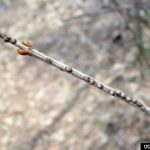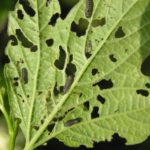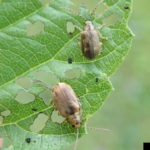With their attractive fruit, flowers, and fall color, viburnums are popular shrubs in Indiana landscapes. Indeed their popularity extends into our native forests, where the fruit and leaves of these native plants are food for birds and other wildlife. Viburnums enjoy a natural resistance to many pests including Japanese beetles. The arrival of the viburnum leaf beetle, Pyrrhalta viburni, in the US threatens the health of viburnums. Although recently established in Illinois, Michigan, Wisconsin and Ohio, the viburnum leaf beetle has yet to be formally detected in Indiana. Containing this beetle before it becomesestablished in Indiana will save time, money, and natural resources. If you think you have seen viburnum leaf beetle or its damage report it via the 1-866-NO-EXOTIC phone number, the GLEDN app, or on the EDDMaps website.
Viburnum Leaf Beetle Identification
Beetles winter as eggs on stems. Their characteristic small rough bumps can be easily detected during the dormant season.

Figure 1. Viburnum leaf beetles lay eggs on stems. (Photo by P. Weston, Cornell University, Bugwood.org)
Eggs hatch in May into green larvae that skeletonize leaves. You may have noticed holes in leaves or the larvae feeding on plants. After completing their development in mid-June, larvae will drop to the ground where they transform into the pupae that will eventually become adults.

Figure 2. Spiny larvae of viburnum leaf beetles chewing holes in leaves. (Photo by M. Zubrik, Forest Research Institute, Slovakia, Bugwood.org)
Golden colored adults will emerge in July to resume feeding on leaves. Feeding and eventually egg laying will continue until frost.

Figure 3. Adult beetles feeding on leaves (Photo by W. Cranshaw, Colorado State University, Bugwood.org)
Viburnum Leaf Beetle Management
Arrowwood and cranberry bush viburnums are most susceptible to this pest. Doublefile and Koreanspice viburnums are resistant to this insect. Control this pest in dormant season by removing stems with obvious egg masses. In March prior to bud break, apply horticulture oil at the dormant rate (4%) to kill eggs glued to stems. When larvae are present on leaves 2% applications of insecticidal soap or spinosad (Captain Jack’s Deadbug) will kill larvae. These two methods are preferred because they spare many of the beneficial insects that can attack and manage populations of the viburnum leaf beetle. Other products like bifenthrin and permethrin can be used to kill adults and larvae but care should be taken to avoid applying product when shrubs are in flower to avoid killing bees and other pollinators.
What are viburnum shrubs and how to identify them. www.hort.cornell.edu/vlb/key/index.html